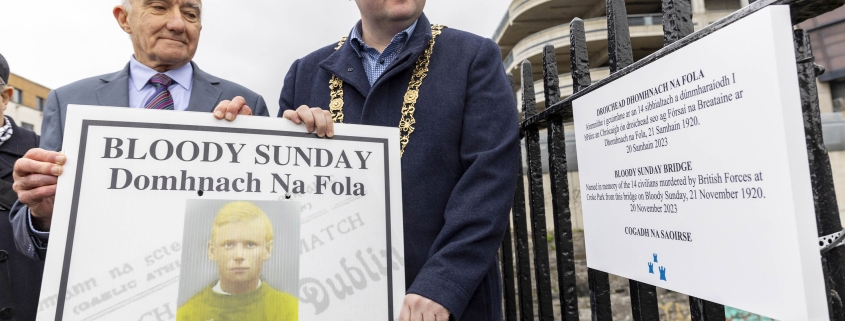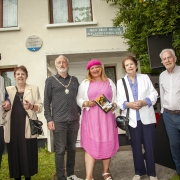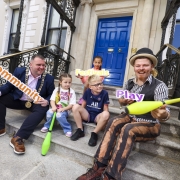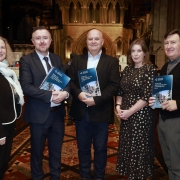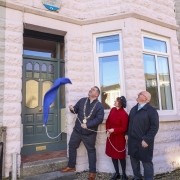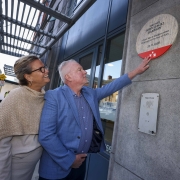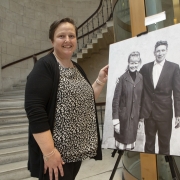Bloody Sunday Bridge plaque unveiled by Dublin City Council
Bloody Sunday Bridge has been officially named by Lord Mayor of Dublin Daithí de Róiste at a Dublin City Council ceremony today. Located in the shadow of Croke Park on Russell Street, this was the site of extreme bloodshed in the midst of the War of Independence on Sunday 21st November 1920.
Earlier this morning, the Lord Mayor Daithí de Róiste also unveiled a Dublin City Council commemorative plaque outside 69 Blessington Street, the home of ten year old Jerome O’Leary, the youngest of the three children killed in the shooting.
youngest of the three children killed in the shooting.
Bloody Sunday, that fateful day 103 years ago, began with the killing by Michael Collins’s ‘The Squad’ of fourteen suspected British intelligence officers. By late afternoon, fourteen innocent civilians, including three children, lay dead or dying, shot by Crown forces from the bridge over the Royal Canal at Russell Street as a Gaelic football match took place in Croke Park. The day of bloodshed ended with the killings in Dublin Castle of Conor Clune and Dublin brigade IRA officers Dick McKee and Peadar Clancy.
Jerome O’Leary, the youngest victim of that terrible day, was sitting on the wall at the canal end, lifted up by his father to watch the match when he was shot from the bridge. He is buried in Glasnevin where for many years his grave went unmarked. As part of its Bloody Sunday Graves project in 2019 the GAA erected a headstone there for Jerome. Now Jerome O’Leary will also be remembered at the house where he lived, 69 Blessington Street.
Speaking at the unveiling, Lord Mayor of Dublin Daithí de Róiste said: “We stand here within easy reach of the spot where ten-year old Jerome O’Leary was sitting, on the wall at the canal end, when he was shot from this bridge on 21 November 1920. Another 13 civilians were killed here on that horrific afternoon, and in naming this bridge we are honouring those innocent victims, all of whom deserve to be remembered.”
He continued, “It was the release of papers by the British authorities, put into storage in London but released early in the aftermath of the Good Friday Agreement, that enabled the record to be put straight about Bloody Sunday. They showed even the British army’s command chain knew they had gone too far, and that the Dublin Metropolitan Police contradicted the propaganda being put out by Dublin Castle.
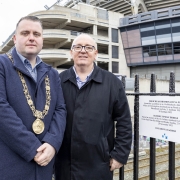 “There is a lesson there. That the truth will win out, eventually, even from darkest hours of a conflict situation. It is a lesson from our conflict of a century ago that could be learned by parties in all conflicts, then and now. Sadly, tonight’s headlines will once again be about the death of non combatants, children like Jerome O’Leary, in other conflicts in other lands far away from Croke Park.”
“There is a lesson there. That the truth will win out, eventually, even from darkest hours of a conflict situation. It is a lesson from our conflict of a century ago that could be learned by parties in all conflicts, then and now. Sadly, tonight’s headlines will once again be about the death of non combatants, children like Jerome O’Leary, in other conflicts in other lands far away from Croke Park.”
The Dublin City Council commemorative plaque marking Jerome O’Leary’s home at 69 Blessington Street was proposed by Pearse Turner.
The decision to name Bloody Sunday Bridge and to erect the plaque in Blessington Street was made by the Dublin City Council Commemorations & Naming Committee, whose chair, Councillor Vincent Jackson, said, “The Commemorative Plaques Scheme allows the City to formally commemorate people who have made a significant contribution to the life of Dublin. We welcome suggestions from the public for people and events to be commemorated and full details are on the Council website.”
Note to the editor:
Dublin City Council’s Commemorative Plaques Scheme is intended to facilitate the formal commemoration of people, organisations, and events that have made a unique and significant contribution to the life or history of Dublin through outstanding achievement, distinctive service or significant community contribution.
Proposals to commemorate living persons will not be considered.
Nominees must have died at least 20 years previously or have passed the centenary of their birth, whichever is earlier.
Members of the public can propose a commemorative plaque on the official form.
Full details, including the application form and the list of plaques erected so far, can be found at www.plaquesofdublin.ie

